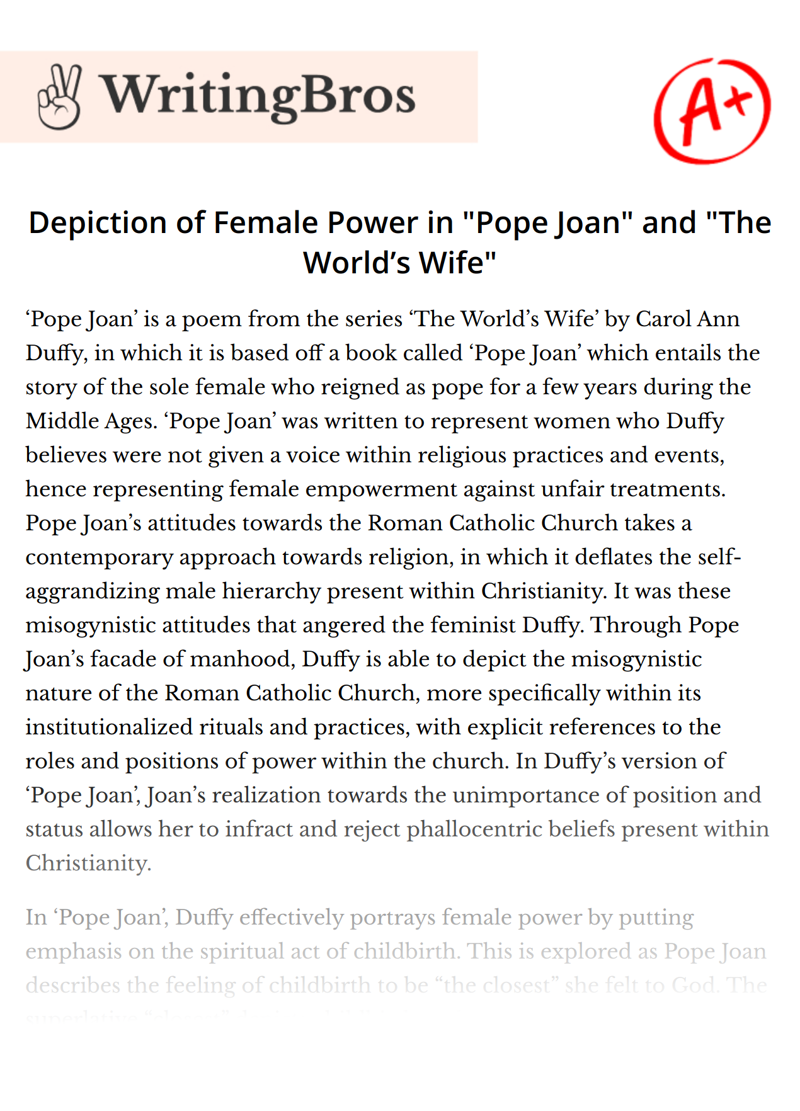Depiction of Female Power in "Pope Joan" and "The World’s Wife"

‘Pope Joan’ is a poem from the series ‘The World’s Wife’ by Carol Ann Duffy, in which it is based off a book called ‘Pope Joan’ which entails the story of the sole female who reigned as pope for a few years during the Middle Ages. ‘Pope Joan’ was written to represent women who Duffy believes were not given a voice within religious practices and events, hence representing female empowerment against unfair treatments. Pope Joan’s attitudes towards the Roman Catholic Church takes a contemporary approach towards religion, in which it deflates the self-aggrandizing male hierarchy present within Christianity. It was these misogynistic attitudes that angered the feminist Duffy. Through Pope Joan’s facade of manhood, Duffy is able to depict the misogynistic nature of the Roman Catholic Church, more specifically within its institutionalized rituals and practices, with explicit references to the roles and positions of power within the church. In Duffy’s version of ‘Pope Joan’, Joan’s realization towards the unimportance of position and status allows her to infract and reject phallocentric beliefs present within Christianity.
In ‘Pope Joan’, Duffy effectively portrays female power by putting emphasis on the spiritual act of childbirth. This is explored as Pope Joan describes the feeling of childbirth to be “the closest” she felt to God. The superlative “closest” depicts childbirth as the ultimate spiritual female experience. Joan wasn’t able to feel connected to God as a male pope, only during labor is when she feels closer to God than ever; an experience only women can go through. This allows Duffy to present the theme of the role of women. Because the Roman Catholic Church rejects the idea of female leaders and priests, Duffy intentionally uses this idea of gender roles to show opposition towards the male hierarchy within the Church. The ecstasy and excitement of motherhood are further bolstered by the quotes “Lifting me, flinging me down”. The repetition of these verb phrases is ambiguous, as Joan could be physically “Lifted” by people transporting her on her papal chair, but it also represents the intimate physicality of contractions of childbirth which ultimately triumphs over her status as a pope, hence showing how motherhood is much more significant and powerful than a measly follower of God. The use of shorter, fast-paced lines heightens the intensity and impassion of childbirth, giving power to the female body. The concluding phrase “Not a man or a pope at all” further emphasizes the celebration of womanhood and motherhood over meaningless male power, as men are seen to exclude women from the Church but God is seen to exclude men from the most spiritual act of all.
Moreover, Duffy asserts her feminist voice in the poem through explicitly portraying Joan to possess the virtues of a strong and intelligent woman. This is seen from when Joan, through a first-person persona, introduces the reader to her life as a pope, in which she had “learned to transubstantiate”. The dynamic verb “transubstantiate” refers to a ritual that can only be officiated by male priests, as it is performed during a high point in service. Due to this, it depicts men with positions of power and importance. However, despite being a woman, Joan is still able to “learn” how to perform such a cardinal act. The verb “learned” creates a casual and colloquial tone which therefore juxtaposes with the importance of such an act, as an act with this degree of importance shouldn’t be able to be easily “learned”, especially not by a woman. This shows how easily Joan is able to surpass men, hence allowing Duffy to introduce the theme of gender. Duffy recognizes the intellect and abilities that women have, but they can only be demonstrated when on a level playing field with men. As a woman, Joan is incapable; as a man, she is able to demonstrate her intelligence. She is the same person but is empowered by dressing as a man and in doing so, readers are shown the disadvantages women have within religion in which both women and men should gain the same respect and equal footing.
Cite this Essay
To export a reference to this article please select a referencing style below

